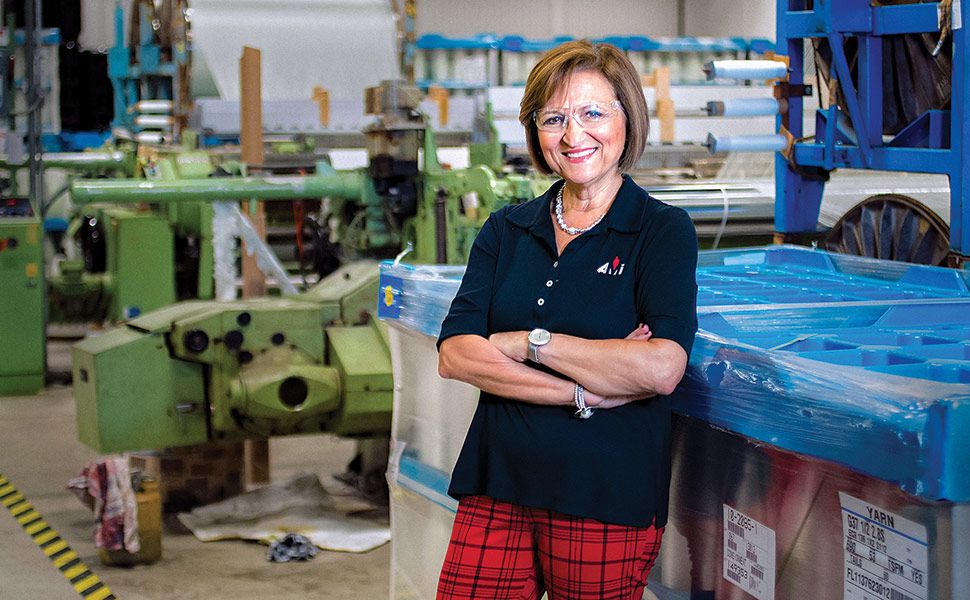Manufacturing a workforce
 Photo / Tim Greenway
CEO Kathie Leonard of Auburn Manufacturing Inc., at the company’s manufacturing site in Mechanics Falls.
Photo / Tim Greenway
CEO Kathie Leonard of Auburn Manufacturing Inc., at the company’s manufacturing site in Mechanics Falls.
In 2017, Auburn Manufacturing Inc. CEO Kathie Leonard did something unheard of — she raised pay across the board up by $2 an hour, a move that nudged up rates of pay anywhere from 5% to 15% per employee — and even more for overtime rates. Mainebiz spoke with Leonard, the 2018 Mainebiz Business Leader of the Year (small business), about her decision to raise employee pay and the impact it had on the company.
Mainebiz: What were the factors that shaped your decision to raise pay?
Kathie Leonard: As the labor market began tightening in our area in 2016, we began losing some of our newer employees to other companies in the area with higher starting pay rates. Having struggled with this new reality for months, we considered increasing our starting pay rates to be more competitive, but realized that wasn’t fair to those who had worked their way up their job ladders. After many spreadsheet analyses, with $2 per hour being the optimal pay raise to remain competitive, we decided it was the right choice to both retain and attain new employees.
MB: Have you been able to see a measurable impact yet — in terms of interest in open positions and turnover rate?
KL: Our turnover in 2017 was lower than the previous two years. Year-to-date 2018, our turnover is currently at 4% — that’s well below our targeted not to exceed metric of 18.5%, and lower than it has been in the previous five years. So I believe that, yes, we are seeing a measurable impact based on our decision to increase wages. We’ve also seen an improvement in getting folks in quicker. Our average time to hire for hourly employees is at 13.9 days — beating our goal of under 15 days. So not only are we getting employees in quicker, but they are staying longer. We have also seen an improvement in morale and we attribute that not only to the increase in wages but also to moving employees around more and cross training them into different areas within the two facilities.
MB: Did you take any other measures in order to improve retention and recruitment?
KL: I think what else has helped here is that we are a little more flexible on new hires, when they get their first raise, and how we include all of them in the annual performance review. They may not necessarily get the entire increase that someone else may have received but we do take into consideration their work habits and contributions to Auburn Manufacturing Inc. We also let them know that all positions are posted and they are encouraged to apply.
MB: What other tactics have you taken to recruit and retain workers? What has worked and what hasn’t?
KL: In the past year or two we have relied on the local staffing agencies to place from ‘temp’ to ‘hire’ and referrals. We have seen an uptick in several employee referrals, which tells me morale has improved. Current employees are referring friends of theirs and encouraging them to apply and work here. What hasn’t worked is more traditional media, like newspaper ads. We also had a mixed, and not-so-successful retention rate with walk-in applicants.
There finally seems to be a movement with the local schools to educate the kids on local industries, opportunities and manufacturing.
MB: The chronic labor shortage impacts all industries across Maine. What issues need to be addressed to find longer-term solutions?
KL: There finally seems to be a movement with the local schools both at the middle and high school level to educate the kids on local industries, opportunities and manufacturing. The community colleges had moved away from technical training, but there also seems to be a comeback there as well. I just hope they are able to respond soon enough and cater to what industry needs are. The answer can’t be that all community college students must have a two-year degree with all the required classes in cases where a one-year certificate or even specific targeted training could meet the needs of a particular industry. Creating more flexible training and education programs are perhaps not as cost-effective at the community college level, so increased funding at the community colleges would need to be increased.










0 Comments